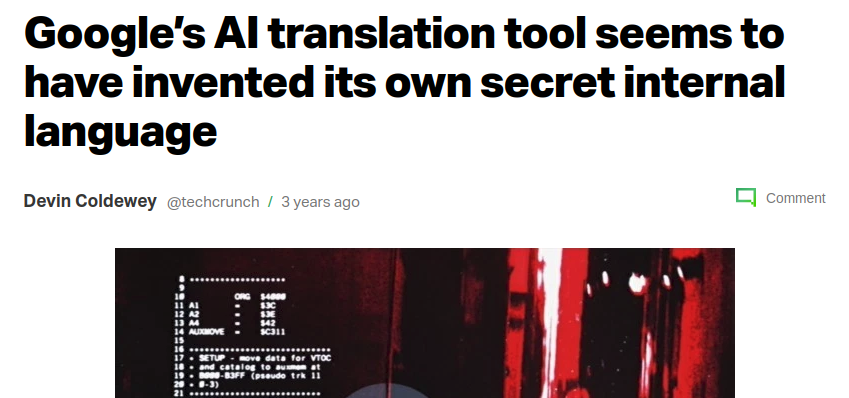Machine Translation Weekly 7: Improved Zero-shot Neural Machine Translation via Ignoring Spurious Correlations
Remember two years ago when all tech-related servers enthusiastically reported that a translator by Google created its own language? These were based on a paper that was published in TAACL in summer 2017 after its pre-print was available on arXiv since November 2016.




The paper was about what we call zero-shot machine translation. In this setup, a single model is trained to be able to translate between many language pairs. This forces the model to learn to represent the inputs in a language-agnostic way and allows the model to work for language pairs that were never seen during training but both the source and the target languages are already well-known to the model. Let’s say you have a single model that you train to translate from English to German, and from French to Czech. If everything goes well, the model will develop a shared representation for English and French and use it to decode either Czech or German. The model should also be able to translate from French to German and from English to Czech. (Yes, it’s fascinating to see something like this work.)
Back in 2016, soon after it became clear that neural machine translation works better than statistical models, I believe most of the researches thought that some kind of zero-shot translation was possible and knew how they would design their experiments if they had the resources. However, there were only a few places with sufficient resources to conduct the experiments. If I recall correctly, at that time our department only had two GPUs (compared to over one hundred right now). Result of the experiments in the 2016 paper posed no real surprise for the community. The translation quality of the zero-shot systems was never better than using English as a pivot language and was too low for any practical use. They showed that zero-shot translation was somehow possible but certainly did not make a breakthrough. Nevertheless, Google did a very good PR job and newspapers happily reported that artificial intelligence created its own language.
Now, two and half years later, outside the media spotlight, researches from Facebook AI, New York University and The University of Hong Kong, published a paper that shows a surprisingly simple way how to make the zero-shot translation work better than pivoting through English. The paper is called Improved Zero-shot Neural Machine Translation via Ignoring Spurious Correlations and was accepted to this year’s ACL.
The original Google paper used a special symbol added to the source sentence that says to which language the sentence should be translated.
<2es> How are you? → ¿Cómo estás?
<2fr> How are you? → Comment ça va?
Authors of the new paper argue (if I simplify that) that this is not a particularly good idea. In the zero-shot setup, the encoder gets a combination of the language tag and the source language that it never encountered during training. In the new paper, the information about the source language is thus passed as a separate input to the decoder.
Most of the improvement comes from using back-translation. Back-translation is a technique for training data augmentation by generating synthetic source-side data using another MT system. It is important that the target data always consist of authentic sentences, so the decoder does not learn to imitate another decoder, but only sentences written by humans. Well-managed back-translation was the key ingredient in the winning systems at the last-year WMT competition. It is also the main technique that enables low-resource and unsupervised translation. You start with not really well-performing systems for translating in both directions and iteratively improve them using back-translation of monolingual text as new training data. (It is kind of similar to how AlphaGo learned to play Go by playing countless games against itself.)
This paper shows that this technique also fits nicely to the zero-shot translation. In the first stage, the model is trained only for the available language pairs. As in the original Google paper, the model has the cool emergent feature that it is able to translate even between language pairs it never encountered during training. This model is used to generate synthetic data for unseen language pairs by back-translation. Finally, the training continues with a mix of authentic and synthetic data.
The obvious drawback compared to the original Google approach is that for n languages, you need to generate n2 sets of parallel data. However, it would be also the case when training n2 translation models, whereas here a single model can be used for multiple language pairs.
BibTeX Reference
@inproceedings{gu2019improved,
title = "Improved Zero-shot Neural Machine Translation via Ignoring Spurious Correlations",
author = "Gu, Jiatao and
Wang, Yong and
Cho, Kyunghyun and
Li, Victor O.K.",
booktitle = "Proceedings of the 57th Annual Meeting of the Association for Computational Linguistics",
month = jul,
year = "2019",
address = "Florence, Italy",
publisher = "Association for Computational Linguistics",
url = "https://www.aclweb.org/anthology/P19-1121",
doi = "10.18653/v1/P19-1121",
pages = "1258--1268",
}
Share the post
@misc{libovicky2019blog0624,
author = "Jindřich Libovický",
title = "Jindřich's Blog -- Machine Translation Weekly 7: Improved Zero-shot Neural Machine Translation via Ignoring Spurious Correlations",
year = "2019",
month = jun,
url = "https://jlibovicky.github.io/2019/06/24/MT-Weekly-Improved-Zero-shot-NMT",
note = "Online, Accessed: 02.04. 2025"
}